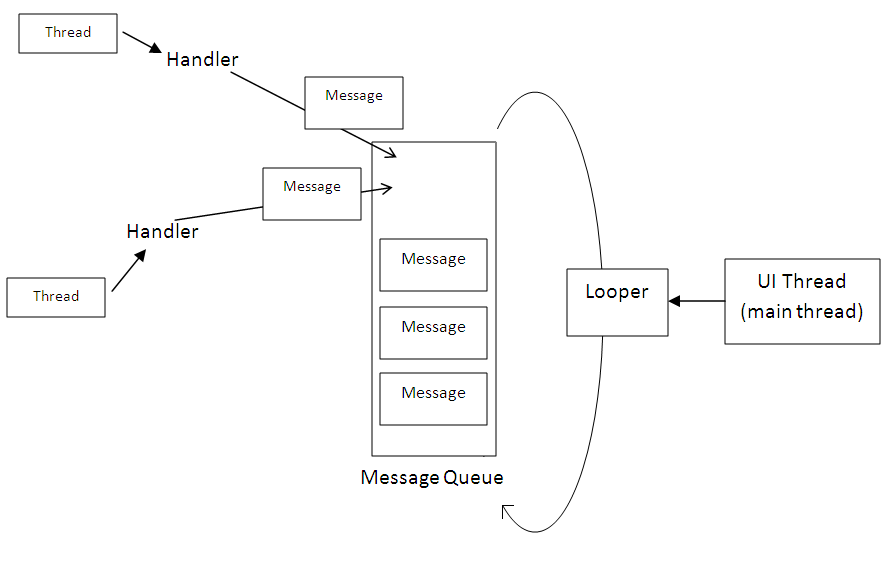
Why do we need multithreading in Android applications?
Let’s say you want to do a very long operation when the user pushes a button.
If you are not using another thread, it will look something like this:
((Button)findViewById(R.id.Button01)).setOnClickListener(
new OnClickListener() {
@Override
public void onClick(View v) {
int result = doLongOperation();
updateUI(result);
}
});
What will happen?
The UI freezes. This is a really bad UI experience. The program may even crash.
The problem in using threads in a UI environment
So what will happen if we use a Thread for a long running operation.
Let’s try a simple example:
((Button)findViewById(R.id.Button01)).setOnClickListener(
new OnClickListener() {
@Override
public void onClick(View v) {
(new Thread(new Runnable() {
@Override
public void run() {
int result = doLongOperation();
updateUI(result);
}
})).start();
}
The result in this case is that the application crashes.
12-07 16:24:29.089: ERROR/AndroidRuntime(315): FATAL EXCEPTION: Thread-8
12-07 16:24:29.089: ERROR/AndroidRuntime(315): android.view.ViewRoot$CalledFromWrongThreadException: Only the original thread that created a view hierarchy can touch its views.
12-07 16:24:29.089: ERROR/AndroidRuntime(315): at ...
Clearly the Android OS wont let threads other than the main thread change UI elements.
But why?
Android UI toolkit, like many other UI environments, is not thread-safe.
The solution
- A queue of messages. Each message is a job to be handled.
- Threads can add messages.
- Only a single thread pulls messages one by one from the queue.
The same solution was implemented in swing (Event dispatching thread
and SwingUtilities.invokeLater() )
Handler
The Handler is the middleman between a new thread and the message queue.
Option 1 – Run the new thread and use the handler to send messages for ui changes
final Handler myHandler = new Handler(){
@Override
public void handleMessage(Message msg) {
updateUI((String)msg.obj);
}
};
(new Thread(new Runnable() {
@Override
public void run() {
Message msg = myHandler.obtainMessage();
msg.obj = doLongOperation();
myHandler.sendMessage(msg);
}
})).start();
* keep in mind that updating the UI should still be a short operation, since the UI freezes during the updating process.
Other possibilities:
handler.obtainMessage with parameters
handler.sendMessageAtFrontOfQueue()
handler.sendMessageAtTime()
handler.sendMessageDelayed()
handler.sendEmptyMessage()
Option 2 – run the new thread and use the handler to post a runnable which updates the GUI.
final Handler myHandler = new Handler();
(new Thread(new Runnable() {
@Override
public void run() {
final String res = doLongOperation();
myHandler.post(new Runnable() {
@Override
public void run() {
updateUI(res);
}
});
}
})).start();
}

Looper
If we want to dive a bit deeper into the android mechanism we have to understand what is a Looper.
We have talked about the message queue that the main thread pulls messages and runnables from it and executes them.
We also said that each handler you create has a reference to this queue.
What we haven’t said yet is that the main thread has a reference to an object named Looper.
The Looper gives the Thread the access to the message queue.
Only the main thread has executes to the Looper by default.
Lets say you would like to create a new thread and you also want to take advantage of the message queue functionality in that thread.
(new Thread(new Runnable() {
@Override
public void run() {
innerHandler = new Handler();
Message message = innerHandler.obtainMessage();
innerHandler.dispatchMessage(message);
}
})).start();
Here we created a new thread which uses the handler to put a message in the messages queue.
This will be the result:
12-10 20:41:51.807: ERROR/AndroidRuntime(254): Uncaught handler: thread Thread-8 exiting due to uncaught exception
12-10 20:41:51.817: ERROR/AndroidRuntime(254): java.lang.RuntimeException: Can't create handler inside thread that has not called Looper.prepare()
12-10 20:41:51.817: ERROR/AndroidRuntime(254): at android.os.Handler.
12-10 20:41:51.817: ERROR/AndroidRuntime(254): at ...
The new created thread does not have a Looper with a queue attached to it. Only the UI thread has a Looper.
We can however create a Looper for the new thread.
In order to do that we need to use 2 functions: Looper.prepare() and Looper.loop().
(new Thread(new Runnable() {
@Override
public void run() {
Looper.prepare();
innerHandler = new Handler();
Message message = innerHandler.obtainMessage();
innerHandler.dispatchMessage(message);
Looper.loop();
}
})).start();
If you use this option, don’t forget to use also the quit() function so the Looper will not loop for ever.
@Override
protected void onDestroy() {
innerHandler.getLooper().quit();
super.onDestroy();
}
AsyncTask
I have explained to you that a Handler is the new thread’s way to communicate with the UI thread.
If while reading this you were thinking to yourself, isn’t there an easier way to do all of that… well, you know what?! There is.
Android team has created a class called AsyncTask which is in short a thread that can handle UI.
Just like in java you extend the class Thread and a SwingWorker in Swing, in Android you extend the class AsyncTask.
There is no interface here like Runnable to implement I’m afraid.
class MyAsyncTask extends AsyncTask<Integer, String, Long> {
@Override
protected Long doInBackground(Integer... params) {
long start = System.currentTimeMillis();
for (Integer integer : params) {
publishProgress("start processing "+integer);
doLongOperation();
publishProgress("done processing "+integer);
}
return start - System.currentTimeMillis();
}
@Override
protected void onProgressUpdate(String... values) {
updateUI(values[0]);
}
@Override
protected void onPostExecute(Long time) {
updateUI("Done with all the operations, it took:" +
time + " millisecondes");
}
@Override
protected void onPreExecute() {
updateUI("Starting process");
}
public void doLongOperation() {
try {
Thread.sleep(1000);
} catch (InterruptedException e) {
e.printStackTrace();
}
}
}
This is how you start this thread:
MyAsyncTask aTask = new MyAsyncTask(); aTask.execute(1, 2, 3, 4, 5);
AsyncTask defines 3 generic types:
AsyncTask<{type of the input}, {type of the update unit}, {type of the result}>
You don’t have to use all of them – simply use ‘Void’ for any of them.
Notice that AsyncTask has 4 operations, which are executed by order.
1. onPreExecute() – is invoked before the execution.
2. onPostExecute() – is invoked after the execution.
3. doInBackground() – the main operation. Write your heavy operation here.
4. onProgressUpdate() – Indication to the user on progress. It is invoked every time publishProgress() is called.
* Notice: doInBackground() is invoked on a background thread where onPreExecute(), onPostExecute() and onProgressUpdate() are invoked on the UI thread since their purpose is to update the UI.
Android developer website also mentions these 4 rules regarding the AsyncTask:
- The task instance must be created on the UI thread.
- execute(Params…) must be invoked on the UI thread.
- Do not call onPreExecute(), onPostExecute(Result), doInBackground(Params…), onProgressUpdate(Progress…) manually.
- The task can be executed only once (an exception will be thrown if a second execution is attempted.)
Timer + TimerTask
Another option is to use a Timer.
Timer is a comfortable way to dispatch a thread in the future, be it once or more.
Instead of doing this:
Runnable threadTask = new Runnable() {
@Override
public void run() {
while(true){
try {
Thread.sleep(2000);
} catch (InterruptedException e) {
e.printStackTrace();
}
doSomething();
}
}
};
(new Thread(threadTask)).start();
do this:
TimerTask timerTask = new TimerTask() {
@Override
public void run() {
doSomething();
}
};
Timer timer = new Timer();
timer.schedule(timerTask, 2000,2000);
which is a bit more elegant.
Bare in mind, you still have to use Handler if you need to do UI operations.
Download sources:
Very neatly written and explained.
But only gripe is, code could have used better formatting / syntax highlighting JS.
Even otherwise, an excellent article.
What a great article. I have googled for a long time looking for a good explanation of the topic, and this one is the best I found. Thanks!
Excellent article, Very clear.
so great article. Thanks!
great article..got clear concept..thanks!
Good article to clear concepts !!
gooodddddddd
in multi threadind there is only one interface Runnable() ????????????????
Thanks a lot, very useful…
A very good article for understanding handler, looper, asynctask. I was reading about them for few days but not able to clear doubts. This article helped me a lot.
Thanks
It’s really a great tutorial on Complete thread handling in android ..
Thank you so much for publishing so nice tutorial….
We have been doing programming without threads, with complexe systems and our UI wouldn’t freeze 🙂
I guess there are many ways to create a piece of software, that will still what it is supposed to do. You can use threads or not and achieve the same thing.
Hi Richard.
If you don’t need threads that’s great.
But the question is: what do you mean by “complex”.
Some of the actions require more time than others.
If for example, your application reads pictures from the internet, than I am afraid you will have to use threads, this action takes a few seconds.
Bear in mind, that the main thread can not be busy for more than 5 seconds, otherwise the OS will pop an alert to the user asking him whether he wishes to close down the application.
Thanks for your comment 🙂
The Best!
Thx, helped alot 🙂
A simple but very useful explanation! thanks!
Hi All the examples I see so far implement the Runnable object as inner class of the main UI Thread Activity. In my up I dont want to do this because my runnable does more things and it also extend TextView. Basically it is a timer that display minutes and second passed and does other things. I want it to be separate class but it does not work. Can someon post an example that uses runnable that modifies a UI but it is a separate class.
Thanks
Karol
Hey did you ever work out your problem as i have the same one.
Really simple and useful explanation about threading.i was searching like this.thanks
Excellent article! Thanks!
> Notice that AsyncTask has 4 operations, which are executed by order.
Shouldn’t that “order” be 1,3,2 ????
> The task can be executed only once (an exception will be
> thrown if a second execution is attempted.)
Once per ….. ?
Per day?
Per minute?
After the first one finishes… you can start another?
It says only *ONCE*? So you can NEVER execute this again?
NEVER?
So if I need this 10 times… I have to cut/paste all the code in… 10 times????
No, you’d simply have to make a new instance of the object and call execute on that.
Really good…thanks!
huuuuuuuuuuuuuuuuuuuuuuuu, like like
Great tutorial! Thank you!
十分感谢
thanks!
Great tutorial… Thanks for sharing..
Tnx,very useful!